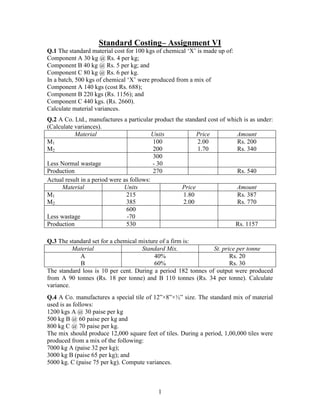
Mbaptscv ijuly2009
- 1. Standard Costing– Assignment VI<br />Q.1 The standard material cost for 100 kgs of chemical ‘X’ is made up of: <br />Component A 30 kg @ Rs. 4 per kg; <br />Component B 40 kg @ Rs. 5 per kg; and <br />Component C 80 kg @ Rs. 6 per kg. <br />In a batch, 500 kgs of chemical ‘X’ were produced from a mix of <br />Component A 140 kgs (cost Rs. 688); <br />Component B 220 kgs (Rs. 1156); and <br />Component C 440 kgs. (Rs. 2660). <br />Calculate material variances. <br />Q.2 A Co. Ltd., manufactures a particular product the standard cost of which is as under: (Calculate variances). <br />MaterialUnitsPriceAmountM11002.00Rs. 200M22001.70Rs. 340Less Normal wastage300- 30Production270Rs. 540<br />Actual result in a period were as follows: <br />MaterialUnitsPriceAmountM12151.80Rs. 387M23852.00Rs. 770600Less wastage-70Production530Rs. 1157<br />Q.3 The standard set for a chemical mixture of a firm is: <br />MaterialStandard Mix.St. price per tonneA40%Rs. 20B60%Rs. 30<br />The standard loss is 10 per cent. During a period 182 tonnes of output were produced from A 90 tonnes (Rs. 18 per tonne) and B 110 tonnes (Rs. 34 per tonne). Calculate variance. <br />Q.4 A Co. manufactures a special tile of 12”×8”×½” size. The standard mix of material used is as follows: <br />1200 kgs A @ 30 paise per kg <br />500 kg B @ 60 paise per kg and <br />800 kg C @ 70 paise per kg. <br />The mix should produce 12,000 square feet of tiles. During a period, 1,00,000 tiles were produced from a mix of the following:<br />7000 kg A (paise 32 per kg); <br />3000 kg B (paise 65 per kg); and <br />5000 kg. C (paise 75 per kg). Compute variances. <br />Q.5 The standard set for output of a company is as under: <br />MaterialStandard MixStandard price per kg.A40%Rs. 4B60%Rs. 3<br />The standard loss is 15 per cent of input. During April 2007, the company produced 1,700 kgs of finished output. The materials details are given below: <br />MaterialOpening StockClosing StockPurchase in AprilA35 kg.5 kg. 800 kg. Rs. 3,400B40 kg.50 kg.1,200 kg. Rs. 3,000<br />Q.6 A gang of workers normally consists of 30 men, 15 women and 10 boys. The standard hourly labour rates are – Men: 80 paise, Women: 60 paise, and boys: 40 paise. In a normal week of 40 hours, the gang is expected to produce 2000 unit of output. <br />During the week ended December 31, 2007, the gang consisted of 40 men, 10 women and 5 boys. The actual wage rates were 70 paise, 65 paise, and 30 paise respectively. 4 hours were lost due to power breakdown, Actual output 1600 units. Compute labour variances. <br />Q.7 A gang of workers normally consists of 10 skilled, 5 semi-skilled and 5 unskilled workers paid at standard hurly rates 75p, 50p, and 40p respectively. In a normal working week of 40 hours the gang is expected to produce 1,000 unit of output. <br />In a certain week, the gang consisted of 13 skilled, 4 semi-skilled and 3 unskilled workers and produced 1,000 units. Actual wages Rs. 450. Actual hours worked 720. Assuming that each worker worked the same hours, compute variances. <br />Q.8 The standard labour and actual labour engaged in a week for a job are as under: <br />SkilledSemi-skilledUnskilledStandard No. of workers32126Standard hourly Rate (Rs.)321Actual No. of workers28184Actual Hourly Rate (Rs.)432<br />During the 40 hour working week, the gang produced 1,800 standard labour hours of work. Compute variances. <br />Q.9 In a factory, 100 workers are engaged and an average rate of wages is Rs. 5 per hour. Standard working hours per week are 40 hours and the standard output is 10 units per hour. During a week in February, wages were paid for 50 workers @ Rs. 5 per hour, 10 workers @ Rs. 7 per hour and 40 workers @ Rs. 4 per hour. Actual output was 380 units. The factory did not work for 5 hours due to breakdown of machinery.<br />Calculate – (i) Labour cost variance; (ii) Labour rate variance; (iii) Labour efficiency variance; and (iv) Idle time variance.<br />Q.10 The standard labour – mix for producing 100 units a of product is:<br /> 4 skilled men @ Rs. 3 per hour for 20 hours<br /> 6 unskilled men @ Rs. 2 per hour for 20 hours<br />But due to shortage of skilled men, more unskilled men were employed to produce 100 units. Actual hours paid for were:<br /> 2 skilled men @ Rs. 4 per hour for 25 hours<br /> 10 unskilled men @ Rs. 2.50 per hour for 25 hours. Calculate labour variances.<br />
